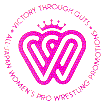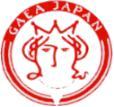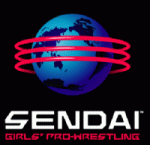
1968-2005
The Matsunaga brothers organized All Japan Women's Pro-Wrestling, which would become known as "Zenjo" ("Zen" meaning "All" and "jo" being short for "joshi" meaning "women"). In the early 70s, they worked out a TV deal with Fuji Television. They also began holding larger shows and sixteen year old Mach Fumiake became their breakout star in 1974. She captured the WWWA World Championship, which would become Zenjo's signature title. Fumiake also became the first joshi puroesu star to sing and record an album - this would become a staple of the product in the decade. When Fumiake retired, the Beauty Pair (Jackie Sato and Maki Ueda) took over and in `76 and `77, they were perhaps the hottest commodity in puroresu. Their popularity inspired a generation of girls that took over in the 1980s. While the Beauty Pair had an appeal that inspired many girls, they were replaced by a crew of ground-breaking workers who took joshi puroresu to a new level. At the forefront was a pint-sized super worker Jaguar Yokota followed by the bully Devil Masami, Mimi Hagewara, the exciting Jumping Bomb Angels (Noriyo Tateno & Itsuki Yamazaki) and the hugely successful and very talented Crush Girls (Chigusa Nagayo & Lioness Asuka) who feuded with Gokuaku Domei, a stable of violent monster heels. A rival company started in 1986, but Zenjo remained the premier group through the interpromotional days in the early 1990s. JWP had much to offer, but Zenjo continued to pump out top-notch talent with ability, charisma and sex appeal. However, their manadatory retirement age that had kept their talent fresh, became deterimental as established stars and new promotions started up throughout the late 1990s. Others cited the company's strict policies. These comhined factors led to a fast decline for All Japan Women. In 2005, the Matsunagas were battling personal and physical problems and the group folded.
1987 Team Gold Combo (Manami Toyota & Toshiyo Yamada)
Amazing Kong
Chaparrita Asari
Lioness Asuka
Beauty Pair (Jackie Sato & Nancy Kumi)
Black Pair (Mami Kumano & Yumi Ikeshita)
Calgary Typhoons (Mika Komatsu & Yumi Ogura)
Crush Gals (Chigusa Nagayo & Lioness Asuka)
Double Inoue (Kyoko Inoue & Takako Inoue)
Dream Orca (Etsuko Mita & Toshiyo Yamada)
Dynamite Girls (Jumbo Hori & Yukari Omori)
The Fire Jets (Yumiko Hotta & Mitsuko Nishiwaki)
Flash 7 (Hikaru & Nanae Takahashi)
Miyuki Fujii
Yumi Fukawa
Mach Fumiake
Golden Pair (Nancy Kumi & Victoria Fujimi)
Ayako Hamada
HIKARU
Keiko Hirose
Akira Hokuto
Honey Wings (Kaoru Maeda & Mika Takahashi)
Jumbo Hori
Yumiko Hotta
Yumi Ikeshita
Kyoko Inoue
Takako Inoue
Kaoru Ito
Grizzly Iwamoto
Jumping Bomb Angels (Noriyo Tateno & Itzuki Yamazaki)
Jungle Jack (Aja Kong & Bison Kimura)
KAORU
Nobuko "Bison" Kimura
Aja Kong
Megumi Kudo
Kumiko Maekawa
Marine Wolves (Akira Hokuto & Suzuka Minami)
Devil Masami
Dump Matsumoto
MihoKayo (Kayo Noumi & Miho Wakizawa)
Etsuko Mita
Kana Mizaki
Emi Motokawa
Chigusa Nagayo
Momoe Nakanishi
Bull Nakano
NANA*MOMO* (Momoe Nakanishi & Nanae Takahashi)
Kayo Noumi
Yumi Ogura
Yukari Omori
Michiko Omukai
Red Typhoons (Kazue Nagahori & Yumi Ogura)
Condor Saito
SASORI
Jackie Sato
Mima Shimoda
Pantera Surena
Nanae Takahashi
Rie Tamada
Tokyo Sweethearts (Manami Toyota & Mima Shimoda)
Noriyo "Combat" Toyoda
Manami Toyota
Hisako Uno (Akira Hokuto)
Miho Wakizawa
Tomoko Watanabe
Itsuki Yamazaki
Jaguar Yokota
Mariko Yoshida
Crane Yu
ZAPS (ZAP I & ZAP T)
M'Style
SUN
Foreigners
I'd like to thank a great number of people and websites. Information has been
gathered from innumerable sources: Dave Meltzer, Zach Arnold, "PUNQ"
and a number of people who frequent credible message boards. I'd also like to credit
Michiko Kubota's defunct cherrybabe.com website (check it out through archive.org),
James Phillips' site, Irving Brown's joshipuro.com and Mike Lorefice's quebrada.net for
providing a wealth of information. Credit should also go to Dave Ditch, Phil Schneider,
Al Esparza, Brandon Thurston and anyone who posts joshi puroresu on youtube for giving me
visual sources. And, of course Royal Duncun and Gary Will's contributions to
wrestling-titles.com

1986-
The Matsunagas had more or less dominated joshi puroresu for the past twenty years. Their former star, Jackie Sato,
helped start an opposing group in 1986. She used charismatic entertainers and legitimate fighters to capture the attention
of fans. JWP had two key factors that made it appealing to talent. It did not have the strict rules and mandatory
retirement clause that the Matsunaga brothers placed on their girls. Also its approach was to have a more traditional
puroresu product without the wildness that Zenjo began employing. JWP had the potential to overtake All Japan Women, if it
could remain alive long enough and not appear second-rate. They could, theoretically, sign up Zenjo's "old" stars and
build off of those stars' fanbase. The early years would be difficult, but JWP hung strong. They created an alliance with
the UWA in Mexico and were able to import foreign talent. However, as time passed, internal politics began fragmenting
the company and it led to a split in 1992 that saw the creation of two smaller companies - JWP Project and LLPW. The
refined JWP had a deep roster with former AJW star Devil Masami and many of JWP's homegrown talents, namely Dynamite Kansai.
The group also marketed their stars effective as sex symbols as Cuty Suzuki, Hikari Fukuoka and other did revealing
photoshoots and became small-time idols.
Sachie Abe
Carlos Amano
Command Bolshoi
ECO
Hikari Fukuoka
Mikiko Futagami (GAMI)
Kayoko Haruyama
Azumi Hyuga
Shinobu Kandori
Dynamite Kansai
KAORU
Rumi Kazama
KAZUKI
Keito (Keiko Aono)
Tsubasa Kuragaki
Tojuki Leon
Plum Mariko
Devil Masami
Arisa Nakajima
Kaori Ohki
Acute Sae
Manami Toyota
Toshie Uematsu
Erika Watanabe
Kaori Yoneyama
Ran YuYu

1992-
After the JWP split in 1992, it became clear who the problems were between. LLPW's top stars were and remained - Rumi
Kazama and Shinobu Kandori. Tough ladies with legit backgrounds and strong personalities, they became the focal
personalities in the company. "Ladies Legend Pro-Wrestling" also had the support of veteran Noriyo Tateno, who helped
them build up a base of young talent. Though they were never a top company, LLPW had two of the top stars and Kandori was
consistantly considered the top star by the Japanese media. Kazama headed the company through its first decade and then
Kandori took over. It continues to produce a wide variety of stars who are either tough, sexy or unique.
Keiko Aono
Eiger
Mizuki Endo
Mikiko Futagami (GAMI)
Shinobu Kandori
Rumi Kazama
Mako Ogawa
Sayuri Okino
Michiko Omukai
Carol Midori
Yuki Noguchi
Mayumi Ozaki
Obacchi Iizuka
Takako Inoue
Harley Saito
Eagle Sawai
Noriyo Tateno
Combat Toyoda
Shark Tsuchiya
Miho Watabe

1995-2005
In 1994, Chigusa Nagayo returned to pro-wrestling and soon after founded her own company - GAEA. The name is taken
from the Greek goddess of the Earth and GAEA would use a lot of goddess imagery in their production. Soon after they began
a working relationship with FMW, which had a unique women's division, as well as WCW in the United States. They began
training a solid core of talent, which helped their growth. However, it was the regular inflow of established talent that
helped GAEA became the first promotion to seize Zenjo’s long-standing spot as the top joshi puroresu company. In 2000,
the Crush Gals were reunited and GAEA was able to attraction the attention it needed. However, Japanese pro-wrestling was
on the decline as a whole and the fragmented and inconsistent nature of joshi puroresu led to a gradual decline for GAEA.
Nagayo’s dream of innovating women’s wrestling worldwide never came to fruition, but her company certainly left a memorable
mark before their closure in 2005.
Carlos Amano
Lioness Asuka
Ayako Hamada
Sakura Hirota
Dynamite Kansai
KAORU
Sonoko Kato
Aja Kong
Devil Masami
Ayane Mizumura
Chikayo Nagashima
Chigusa Nagayo
Mayumi Ozaki
Police
Sugar Sato
Meiko Satomura
Manami Toyota
Toshie Uematsu
Toshiyo Yamada
Ran YuYu

1995-2007
In the wake of the joshi puroresu boom of the early 1990s, several different groups opened with distinct approaches.
The Jd'Star promotion, with its subtitle, "Beauty Athlete," sums up the company's approach. Jd' is a small promotion and
aside from featuring the legendary Jaguar Yokota, it never had any breakout stars like other joshi puroresu companies did.
Yokota grew frustrated with the stagnation and left in 1998. Kiyu Uji bought Jd’Star, but could never do much with it.
The company had a nice roster, but none with the ability or personalities to attract much attention. In 2001, Jd'
established a gimmick of the "athtress" (athlete-actress), which used girls with model good looks to market them for their
athleticism in the pro-wrestling ring and hopefully establish them as actresses. The stars created more controversy than
anything and the attempt to create an idol never quite caught. Jd’Star continued to flounder in The ocean of Japanese
pro-wrestling companies, before folding in the summer of 2007.
Sachie Abe
Lioness Asuka
The Bloody
Bullfight Sora
Carribean RUM
Cherry
Fuka
HIROKA
Obacchi Iizuka
JYAGIE
KAZUKI
Kyoko Kimura
Tojuki Leon
Saki Maemura
Marcela
MARU
Kuro Maru
Tsuki Maru
Miwa Maruyama
Yuki Miyazaki
Apple Miyuki
Hiroyo Muto
Chiaki Nishi
Azuno Omori
Rei
Keiko Saito
Sumie Sakai
Shu Shibutani
Fang Suzuki
Natsuki Taiyo
Emi Tomimatsu
TSUNAMI
Yuri Urai
Megumi Yabushita
Chitoshi Yamaoto

1998-2003
In 1997, former AJW business manager Hiroshi Ogawa opened ARISON with the support of stars Aja Kong and Sakie Hasegawa.
Mixed Martial Arts was just taking off in Japan and ARISON used that element as part of its image. They developed a
working relationship with BattlARTS that was pivotal to their stylistic development. Integrating lucha libre highflying
was also crucial to the "Visual Fighting" style. ARISON's innovation was not limited to their in-ring wrestling. Like
all of the companies that came after AJW, ARISON had some major stars to help it through its early stages. However,
ARISON nurtured the young talent it had acquired from AJW and LLPW. Within a couple years, they had arguably the best
talent pool in joshi puroresu. Although they, like most other companies, had a small roster, they were well-marketed as
athletes and idols. The company struggled to take their product to the next level and began diverting from their original
intentions. They had a pop group (which bombed), a champion (who did not use the style) and a booker (who focused on
storylines, not match quality). ARISON's niche was compromised and they became just another joshi puroresu company. In
2003, Yumiko Hotta took over the remains and formed "AtoZ".
Sachie Abe
AKINO
Faby Apache
Mary Apache
Chaparrita Asari
Lioness Asuka
Baby*A
Bionic J
Reggie Bennett
Atsuko Emoto
Ai Fujita
Yumi Fukawa
GAMI
Ayako Hamada
Yumiko Hotta
Aja Kong
Lady Metal
Ryo Miyuki
Mika Nishio
noki-A (Mika Akino)
Candy Okutsu
Michiko Omukai
PIKO (Commando Bolshoi)
Reona
Miyuki Ryu
Mima Shimoda
Linda Starr
Rena Takase
Rie Tamada
Yuu Yamagata
Mariko Yoshida

1998-
Despite the struggles of the puroresu scene and the joshi puroresu scene in particular, "NEO Japan Ladies' Wrestling"
opened its doors in 1998. Promoted by Tetsuya Kouda, NEO became one of the unique promotions on the landscape. Its top
star, Kyoko Inoue, was a colorful and popular star, but their undercard was always lacking. They ran a mixture of comedy
wrestling, mixed gender matches and even incorporated mixed martial arts. This variety helped them pull in some decent
crowds, but the company has never really become a top promotion. They closed once and soon reopened as simply "NEO," but
little changed.Inoue's omnipresence on the top has been blasted as the reason for the company's stagnation over the years.
Amazing Kong
Chaparrita Asari
Cherry
Misae Genki
Kayoko Haruyama
Azumi Hyuga
Mai Ichii
Kyoko Inoue
Ayako Ishida
Kyoko Kimura
Aoi Kizuki
Ayumi Kurihara
Haruka Matsuo
Etsuko Mita
Yuki Miyazaki
Tanny Mouse
Chikayo Nagashima
Arisa Nakajima
Yuka Nakamura
Nagisa Nozaki
NEO Machine Guns (Tanny Mouse & Yuki Miyazaki)
Rei
Emi Sakura
Ayako Sato
Shu Shibutani
Yuka Shiina
Yoshiko Tamura
Toshie Uematsu
Junko Yagi
Aya Yuki
Ran YuYu

2003-2006
After Arison's close in 2003, the talent roster under trainer and top star, Mariko Yoshida, united with various Zenjo
stars to create "Major Girl's Fighting AtoZ" (because of "A" in "Arison" and "Z" in "Zenjo"). The unification of talent
seemed to be the best route to success. While they were an able group, Yoshida eventually left in late 2005 to open her
own company and Yumiko Hotta took over as promoter. The promotion ran for a while longer, but it was forced to close
shop the following year.
Sachie Abe
AKINO
baby*A
Bullfight Sora (Atsuko Emoto)
Ai Fujita
GAMI
Yumiko Hotta
Kana (Kanako Urai)
Yukari Kitao
Mirai
Mika Mizunuma
Yasusato Nakajima
Momoe Nakanishi
Mika Nishio
Leona
Mima Shimoda
Reina Takase
Rie Tamada
Mariko Yoshida
2004-2006
After ARISON's closure, their talent core had many different possible directions. Their biggest star, Michiko Omukai,
had interest in forming a new company. New Japan, which was struggling as well, helped with the venture. This alliance
helped Omukai secure some excellent talent from the former ARISON, from the dying Zenjo, from AtoZ and elsewhere. The
company began strongly, despite the tepid nature of pro-wrestling in Japan at the time. However, they quickly sunk in
their attendences and when Omukai's health began declining, she announced its closure after only two and a half years.
AKINO
baby*M
Bullfight Sora
Teruko Kagawa
Ayumi Kurihara
Leon
Momoe Nakanishi
Michiko Omukai
Mariko Yoshida
Mickey Yuka

2005-
Mariko Yoshida built a name for herself as one of the premier trainers in joshi puroresu. She was the ultimate product
of ARISON's "Hyper Visual Fighting" style and has worked to pass on that legacy. After Zenjo and GAEA closed, there were
several groups that opened up, but they largely used freelancers and did not run a complete operations. Most schools were
being operated by these freelancers. Yoshida decided to focus her efforts on developing the next generation of women's
wrestlers in Japan by running a company that focused on the up-and-coming talent. The promotion's name, Ibuki (meaning
"breath"), hints at what goal of the promotion is - to breathe new life into the deflated joshi puroresu sphere.
ESI
Hiroyo Matsumoto
Tomoka Nakagawa
NAO
Akiko Narikuni
Ray
Mariko Yoshida

2005-
Mayumi Ozaki started a stable called "OZ Academy" in 1997 in JWP and GAEA. She was a seasoned wrestler and she
reinvented herself with the group as its sinister head mistress. The stable was a hot commodity for many years and
graduated to running shows in 2005 after AJW and GAEA closed. Although they only run monthly shows, OZ Academy has a
strong enough brand name to make television. They have expanded their operations recently and have become a reliable
product.
Carlos Amano
Ayako Hamada
Natsuki Head
Hikaru
Azumi Hyuga
Dynamite Kansai
Sonoko Kato
Aja Kong
Tsubasa Kuragaki
Ayumi Kurihara
Chikayo Nagashima
Kaori Nakayama
Mika Nishio
Mayumi Ozaki
Sugar Sato
Nanae Takahashi
Manami Toyota
Toshie Uematsu
Ran YuYu

2005-
The mid-00s were unfortunate for joshi puroresu with the top companies (All Japan Women, GAEA and ARISON) all closing
within a matter of months. Several groups were trying to pick up the remains. While there were plenty of stars and
talents floating around, Meiko Satomura was arguably the best of the best. She and Michinoku Pro Wrestling's Jinsei
Shinzaki worked together to create "Sendai Girls," which became known as "Senjo." After a lengthy wait, Senjo debuted with
Satomura as their ace and several legendary figures and has become a success.
Chisako Kanari
Sachiko Kanari
Kyoko Kimura
Aja Kong
Akari Okuda
Mayumi Ozaki
Tsubasa Kuragaki
Meiko Satomura
2006-
Amongst the joshi puroresu companies that started in the wake of AJW and GAEA's respective deaths was SUN. Backed by
the same sponsor as Zero-One MAX, SUN takes a similar approach to that innovative independent. They use a variety of
talent in hopes of providing something for everyone. From stars of yesteryear to outsiders to gaijins, SUN is becoming
one of the better joshi puroresu products in the struggling market.
Amazing Kong
Hikaru
Kyoko Kimura
Saki Maemura
Natsuki Taiyo
Nanae Takahashi
Toshie Uematsu
Women's pro-wrestling has a legacy nearly as long as men's pro-wrestling. Mildred Burke's 1954 Japanese tour sparked
interest in the sport and fourteen years later, a regular promotion with a TV deal was created. Another few years it was
a national phenomenon again and by the 1980s it was a fixture of Japanese television. As with the men's wrestling, women
from numerous countries were brought to Japan. There was not the same level of appeal or the same level of ability, but
ladies from the United States, Canada and Mexico have all had significant runs in Japan.
Bionic J
"Cheerleader" Melissa
Lola Gonzales
La Galactica
Madusa Miceli